BCO6185 - Mobile & Executive Computing: Mobile Business Solutions
VerifiedAdded on 2023/06/11
|12
|2947
|188
Report
AI Summary
This report discusses mobile business solutions, focusing on technologies like user experience design, rapid prototyping, mobile app development, augmented reality, and IoT applications. It examines DXC Technologies as a provider, highlighting their focus on user experience and innovation....
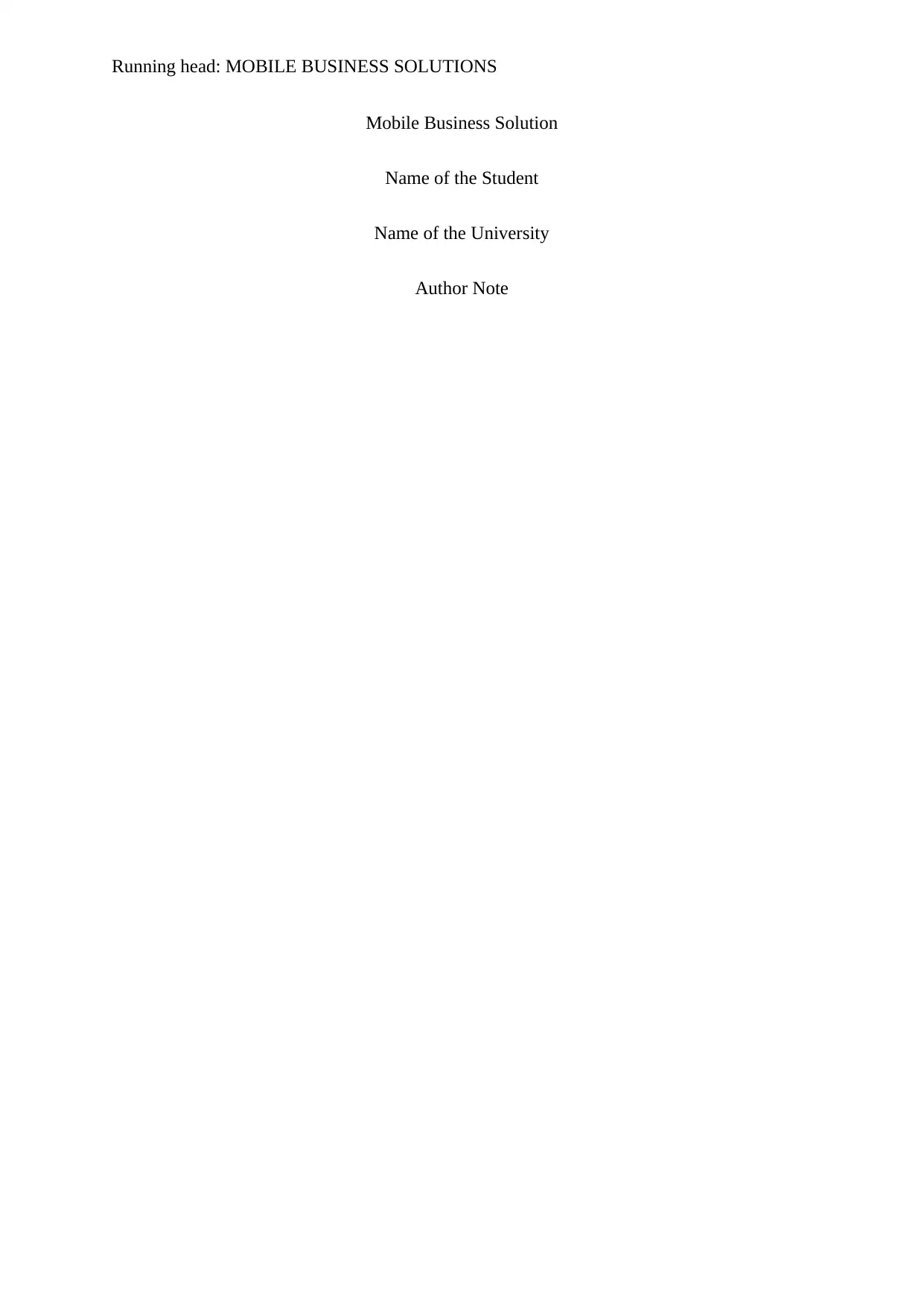
Running head: MOBILE BUSINESS SOLUTIONS
Mobile Business Solution
Name of the Student
Name of the University
Author Note
Mobile Business Solution
Name of the Student
Name of the University
Author Note
Paraphrase This Document
Need a fresh take? Get an instant paraphrase of this document with our AI Paraphraser
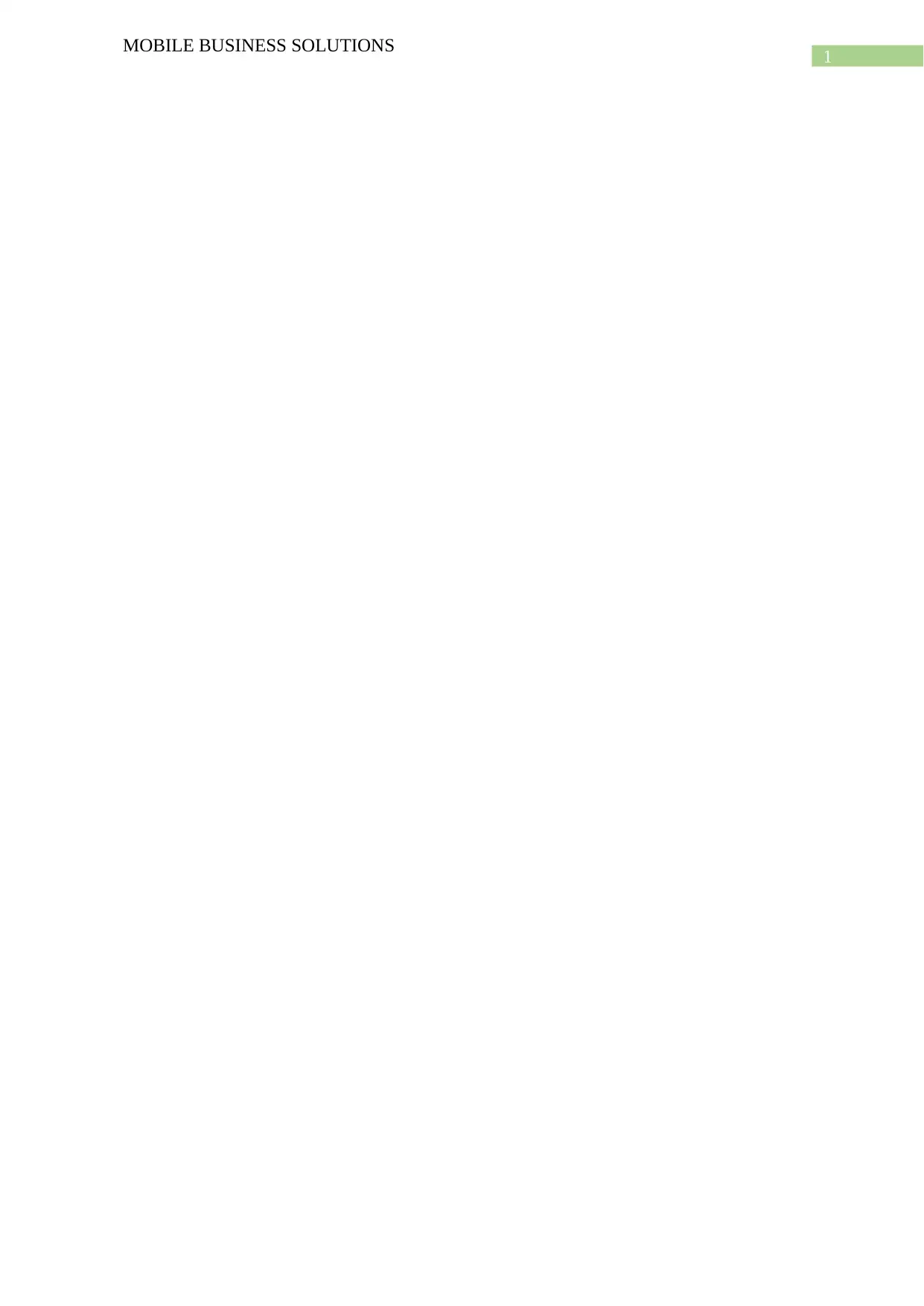
1
MOBILE BUSINESS SOLUTIONS
MOBILE BUSINESS SOLUTIONS
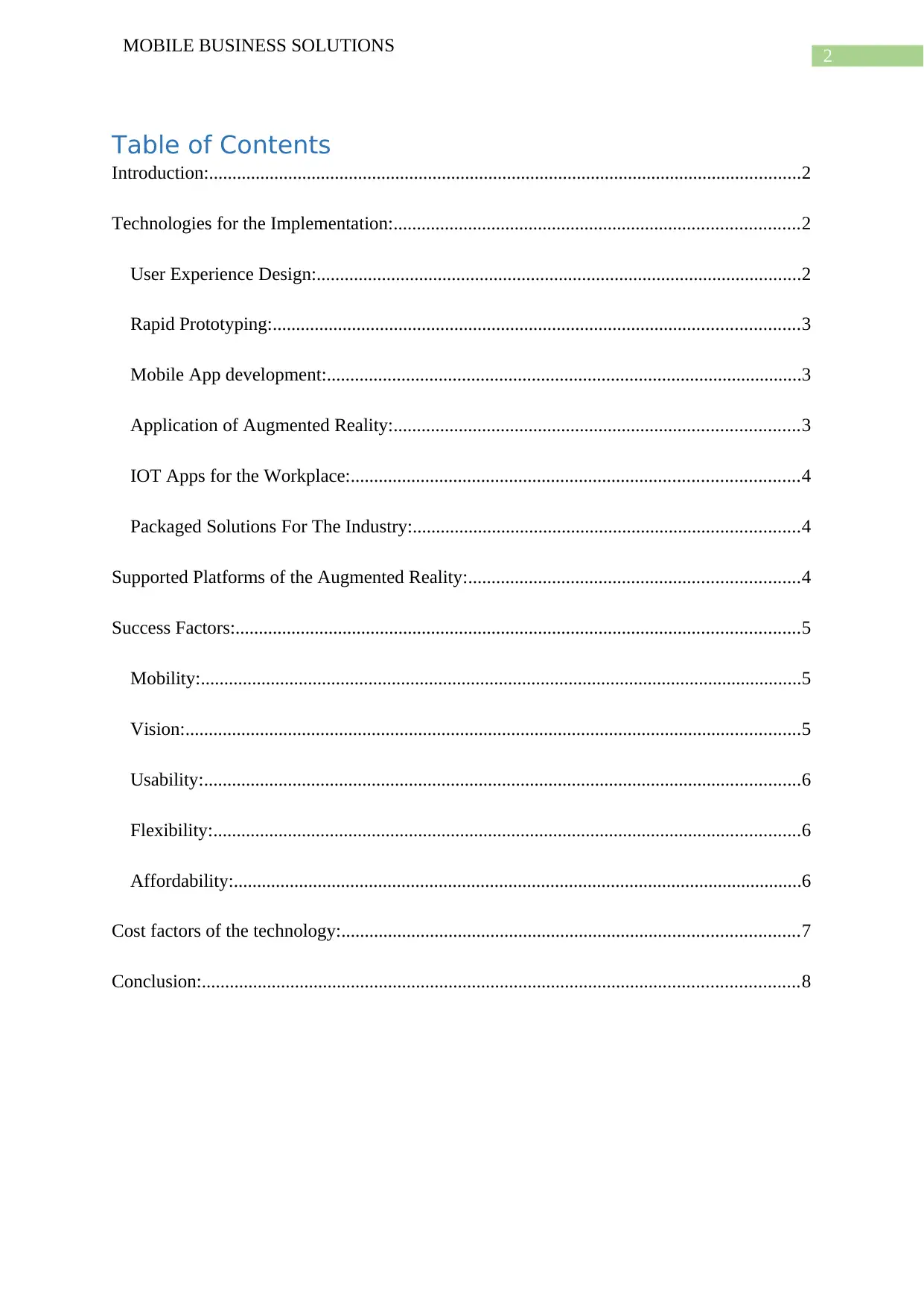
2
MOBILE BUSINESS SOLUTIONS
Table of Contents
Introduction:...............................................................................................................................2
Technologies for the Implementation:.......................................................................................2
User Experience Design:........................................................................................................2
Rapid Prototyping:.................................................................................................................3
Mobile App development:......................................................................................................3
Application of Augmented Reality:.......................................................................................3
IOT Apps for the Workplace:................................................................................................4
Packaged Solutions For The Industry:...................................................................................4
Supported Platforms of the Augmented Reality:.......................................................................4
Success Factors:.........................................................................................................................5
Mobility:.................................................................................................................................5
Vision:....................................................................................................................................5
Usability:................................................................................................................................6
Flexibility:..............................................................................................................................6
Affordability:..........................................................................................................................6
Cost factors of the technology:..................................................................................................7
Conclusion:................................................................................................................................8
MOBILE BUSINESS SOLUTIONS
Table of Contents
Introduction:...............................................................................................................................2
Technologies for the Implementation:.......................................................................................2
User Experience Design:........................................................................................................2
Rapid Prototyping:.................................................................................................................3
Mobile App development:......................................................................................................3
Application of Augmented Reality:.......................................................................................3
IOT Apps for the Workplace:................................................................................................4
Packaged Solutions For The Industry:...................................................................................4
Supported Platforms of the Augmented Reality:.......................................................................4
Success Factors:.........................................................................................................................5
Mobility:.................................................................................................................................5
Vision:....................................................................................................................................5
Usability:................................................................................................................................6
Flexibility:..............................................................................................................................6
Affordability:..........................................................................................................................6
Cost factors of the technology:..................................................................................................7
Conclusion:................................................................................................................................8
⊘ This is a preview!⊘
Do you want full access?
Subscribe today to unlock all pages.

Trusted by 1+ million students worldwide
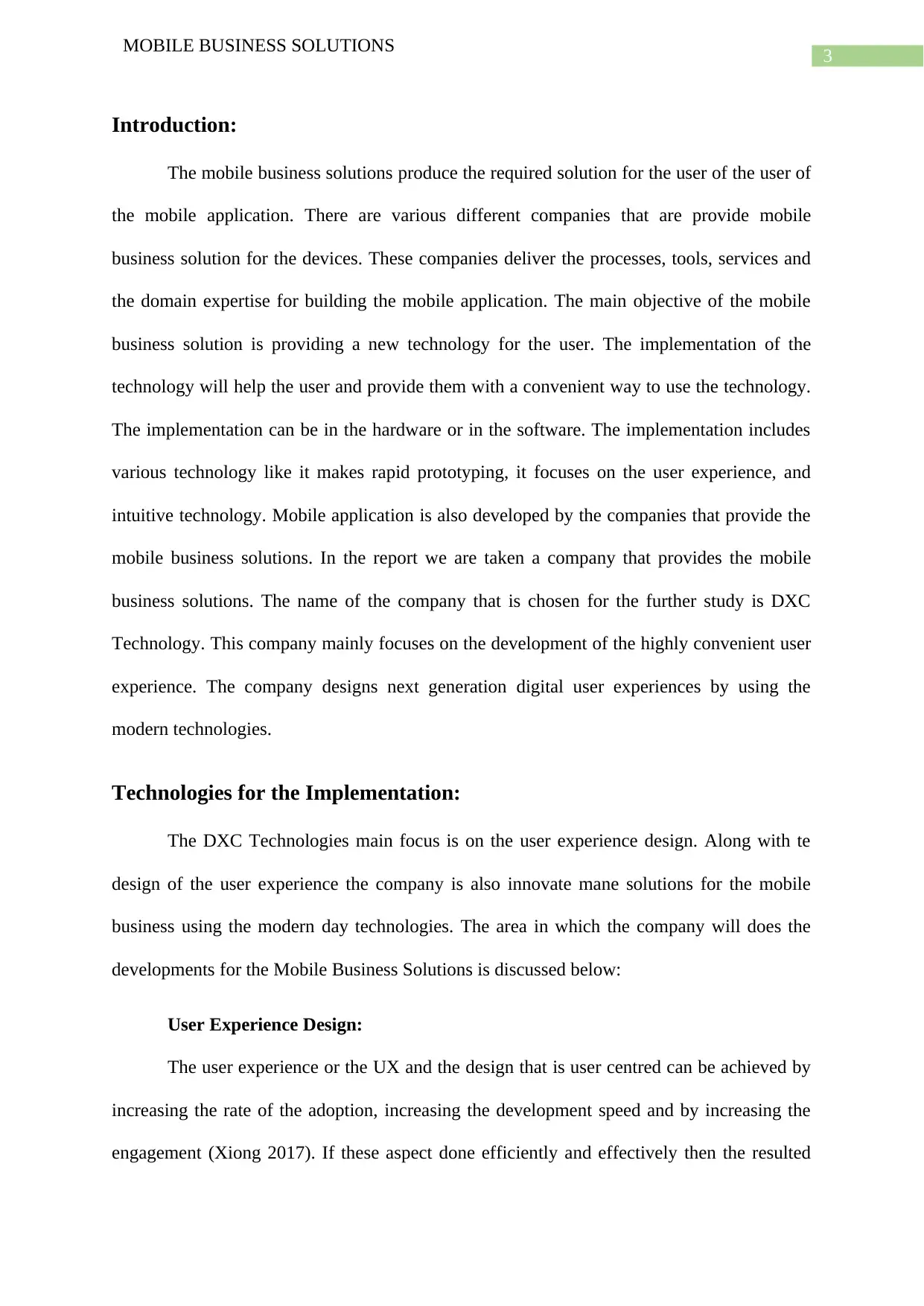
3
MOBILE BUSINESS SOLUTIONS
Introduction:
The mobile business solutions produce the required solution for the user of the user of
the mobile application. There are various different companies that are provide mobile
business solution for the devices. These companies deliver the processes, tools, services and
the domain expertise for building the mobile application. The main objective of the mobile
business solution is providing a new technology for the user. The implementation of the
technology will help the user and provide them with a convenient way to use the technology.
The implementation can be in the hardware or in the software. The implementation includes
various technology like it makes rapid prototyping, it focuses on the user experience, and
intuitive technology. Mobile application is also developed by the companies that provide the
mobile business solutions. In the report we are taken a company that provides the mobile
business solutions. The name of the company that is chosen for the further study is DXC
Technology. This company mainly focuses on the development of the highly convenient user
experience. The company designs next generation digital user experiences by using the
modern technologies.
Technologies for the Implementation:
The DXC Technologies main focus is on the user experience design. Along with te
design of the user experience the company is also innovate mane solutions for the mobile
business using the modern day technologies. The area in which the company will does the
developments for the Mobile Business Solutions is discussed below:
User Experience Design:
The user experience or the UX and the design that is user centred can be achieved by
increasing the rate of the adoption, increasing the development speed and by increasing the
engagement (Xiong 2017). If these aspect done efficiently and effectively then the resulted
MOBILE BUSINESS SOLUTIONS
Introduction:
The mobile business solutions produce the required solution for the user of the user of
the mobile application. There are various different companies that are provide mobile
business solution for the devices. These companies deliver the processes, tools, services and
the domain expertise for building the mobile application. The main objective of the mobile
business solution is providing a new technology for the user. The implementation of the
technology will help the user and provide them with a convenient way to use the technology.
The implementation can be in the hardware or in the software. The implementation includes
various technology like it makes rapid prototyping, it focuses on the user experience, and
intuitive technology. Mobile application is also developed by the companies that provide the
mobile business solutions. In the report we are taken a company that provides the mobile
business solutions. The name of the company that is chosen for the further study is DXC
Technology. This company mainly focuses on the development of the highly convenient user
experience. The company designs next generation digital user experiences by using the
modern technologies.
Technologies for the Implementation:
The DXC Technologies main focus is on the user experience design. Along with te
design of the user experience the company is also innovate mane solutions for the mobile
business using the modern day technologies. The area in which the company will does the
developments for the Mobile Business Solutions is discussed below:
User Experience Design:
The user experience or the UX and the design that is user centred can be achieved by
increasing the rate of the adoption, increasing the development speed and by increasing the
engagement (Xiong 2017). If these aspect done efficiently and effectively then the resulted
Paraphrase This Document
Need a fresh take? Get an instant paraphrase of this document with our AI Paraphraser
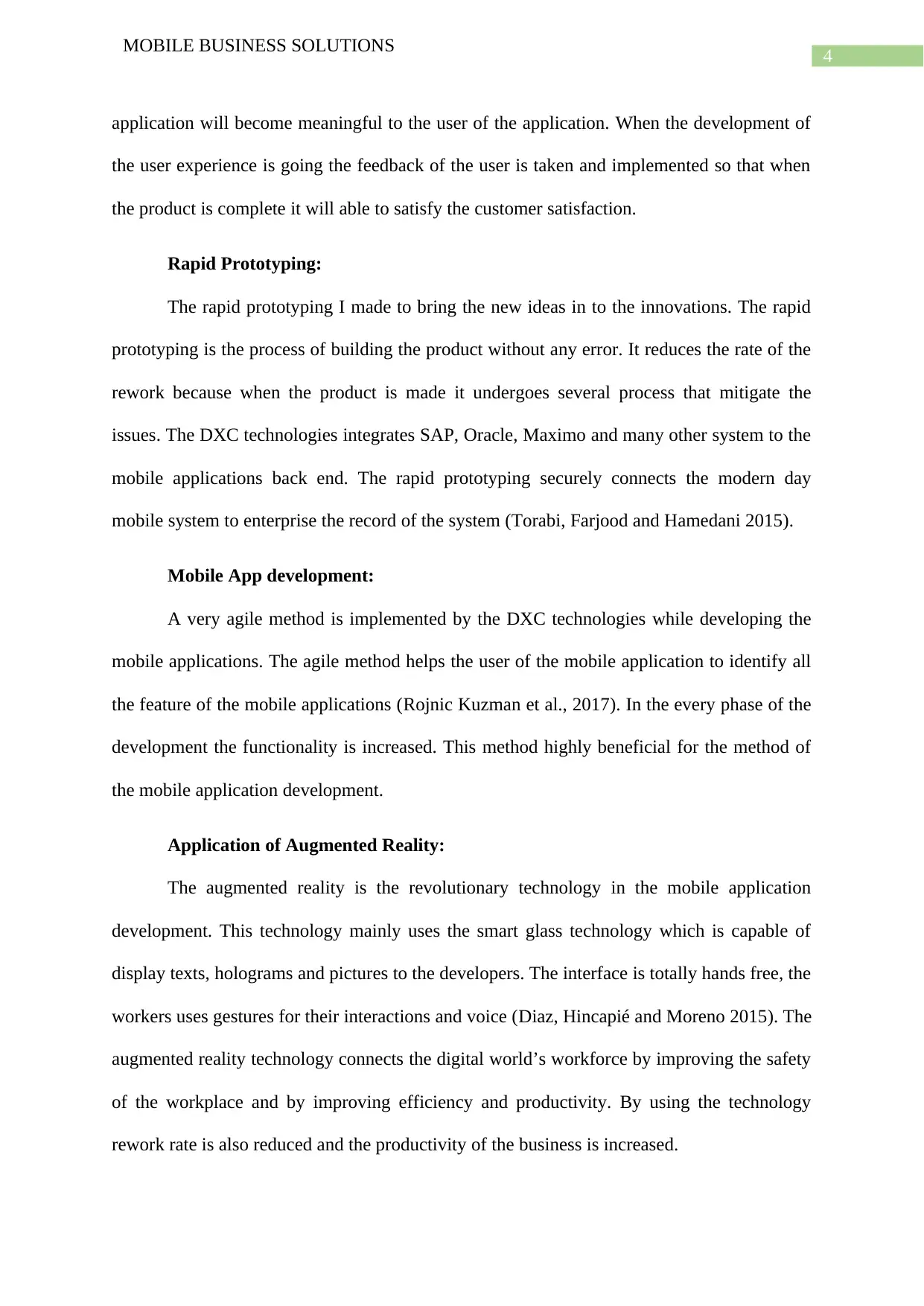
4
MOBILE BUSINESS SOLUTIONS
application will become meaningful to the user of the application. When the development of
the user experience is going the feedback of the user is taken and implemented so that when
the product is complete it will able to satisfy the customer satisfaction.
Rapid Prototyping:
The rapid prototyping I made to bring the new ideas in to the innovations. The rapid
prototyping is the process of building the product without any error. It reduces the rate of the
rework because when the product is made it undergoes several process that mitigate the
issues. The DXC technologies integrates SAP, Oracle, Maximo and many other system to the
mobile applications back end. The rapid prototyping securely connects the modern day
mobile system to enterprise the record of the system (Torabi, Farjood and Hamedani 2015).
Mobile App development:
A very agile method is implemented by the DXC technologies while developing the
mobile applications. The agile method helps the user of the mobile application to identify all
the feature of the mobile applications (Rojnic Kuzman et al., 2017). In the every phase of the
development the functionality is increased. This method highly beneficial for the method of
the mobile application development.
Application of Augmented Reality:
The augmented reality is the revolutionary technology in the mobile application
development. This technology mainly uses the smart glass technology which is capable of
display texts, holograms and pictures to the developers. The interface is totally hands free, the
workers uses gestures for their interactions and voice (Diaz, Hincapié and Moreno 2015). The
augmented reality technology connects the digital world’s workforce by improving the safety
of the workplace and by improving efficiency and productivity. By using the technology
rework rate is also reduced and the productivity of the business is increased.
MOBILE BUSINESS SOLUTIONS
application will become meaningful to the user of the application. When the development of
the user experience is going the feedback of the user is taken and implemented so that when
the product is complete it will able to satisfy the customer satisfaction.
Rapid Prototyping:
The rapid prototyping I made to bring the new ideas in to the innovations. The rapid
prototyping is the process of building the product without any error. It reduces the rate of the
rework because when the product is made it undergoes several process that mitigate the
issues. The DXC technologies integrates SAP, Oracle, Maximo and many other system to the
mobile applications back end. The rapid prototyping securely connects the modern day
mobile system to enterprise the record of the system (Torabi, Farjood and Hamedani 2015).
Mobile App development:
A very agile method is implemented by the DXC technologies while developing the
mobile applications. The agile method helps the user of the mobile application to identify all
the feature of the mobile applications (Rojnic Kuzman et al., 2017). In the every phase of the
development the functionality is increased. This method highly beneficial for the method of
the mobile application development.
Application of Augmented Reality:
The augmented reality is the revolutionary technology in the mobile application
development. This technology mainly uses the smart glass technology which is capable of
display texts, holograms and pictures to the developers. The interface is totally hands free, the
workers uses gestures for their interactions and voice (Diaz, Hincapié and Moreno 2015). The
augmented reality technology connects the digital world’s workforce by improving the safety
of the workplace and by improving efficiency and productivity. By using the technology
rework rate is also reduced and the productivity of the business is increased.
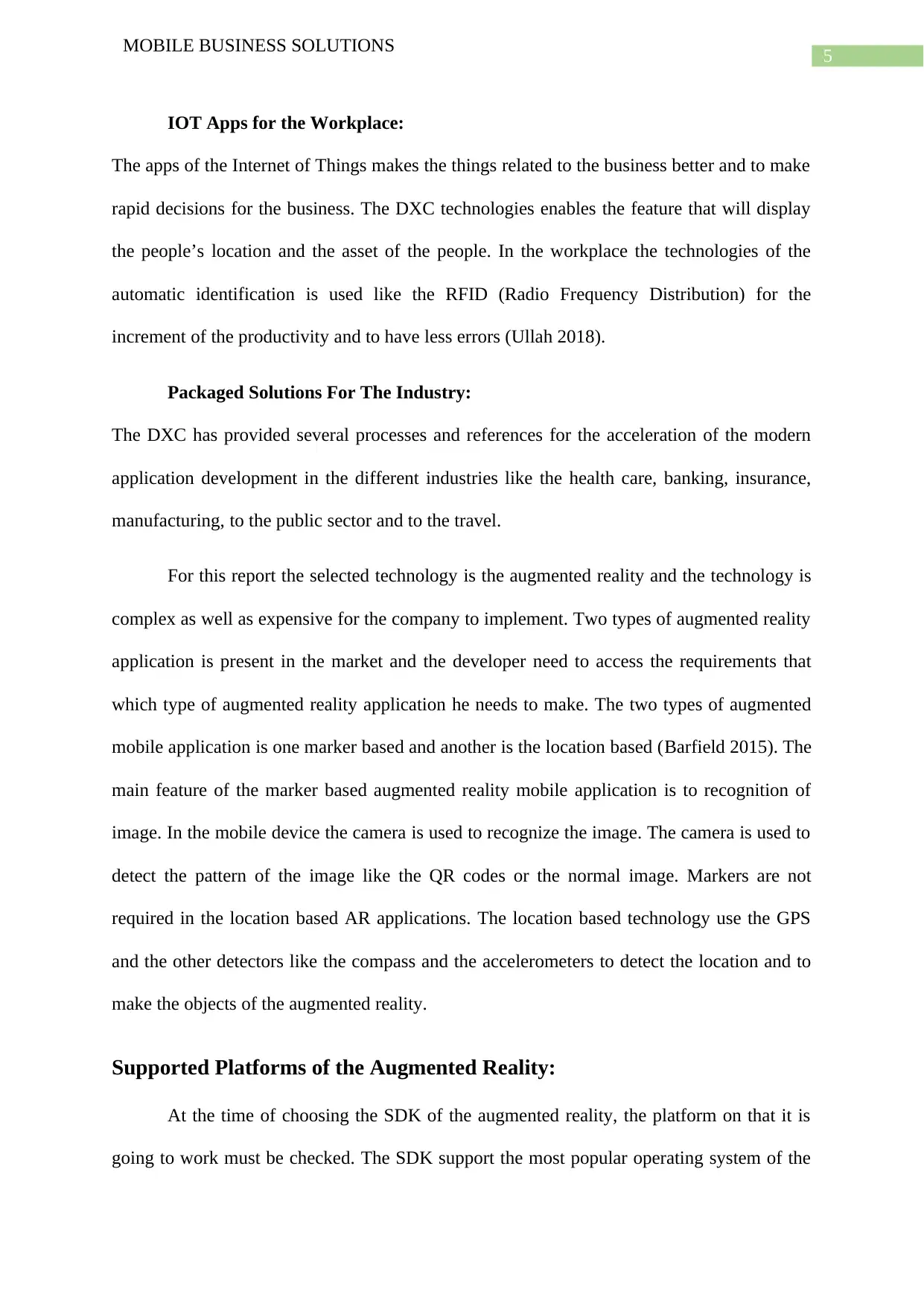
5
MOBILE BUSINESS SOLUTIONS
IOT Apps for the Workplace:
The apps of the Internet of Things makes the things related to the business better and to make
rapid decisions for the business. The DXC technologies enables the feature that will display
the people’s location and the asset of the people. In the workplace the technologies of the
automatic identification is used like the RFID (Radio Frequency Distribution) for the
increment of the productivity and to have less errors (Ullah 2018).
Packaged Solutions For The Industry:
The DXC has provided several processes and references for the acceleration of the modern
application development in the different industries like the health care, banking, insurance,
manufacturing, to the public sector and to the travel.
For this report the selected technology is the augmented reality and the technology is
complex as well as expensive for the company to implement. Two types of augmented reality
application is present in the market and the developer need to access the requirements that
which type of augmented reality application he needs to make. The two types of augmented
mobile application is one marker based and another is the location based (Barfield 2015). The
main feature of the marker based augmented reality mobile application is to recognition of
image. In the mobile device the camera is used to recognize the image. The camera is used to
detect the pattern of the image like the QR codes or the normal image. Markers are not
required in the location based AR applications. The location based technology use the GPS
and the other detectors like the compass and the accelerometers to detect the location and to
make the objects of the augmented reality.
Supported Platforms of the Augmented Reality:
At the time of choosing the SDK of the augmented reality, the platform on that it is
going to work must be checked. The SDK support the most popular operating system of the
MOBILE BUSINESS SOLUTIONS
IOT Apps for the Workplace:
The apps of the Internet of Things makes the things related to the business better and to make
rapid decisions for the business. The DXC technologies enables the feature that will display
the people’s location and the asset of the people. In the workplace the technologies of the
automatic identification is used like the RFID (Radio Frequency Distribution) for the
increment of the productivity and to have less errors (Ullah 2018).
Packaged Solutions For The Industry:
The DXC has provided several processes and references for the acceleration of the modern
application development in the different industries like the health care, banking, insurance,
manufacturing, to the public sector and to the travel.
For this report the selected technology is the augmented reality and the technology is
complex as well as expensive for the company to implement. Two types of augmented reality
application is present in the market and the developer need to access the requirements that
which type of augmented reality application he needs to make. The two types of augmented
mobile application is one marker based and another is the location based (Barfield 2015). The
main feature of the marker based augmented reality mobile application is to recognition of
image. In the mobile device the camera is used to recognize the image. The camera is used to
detect the pattern of the image like the QR codes or the normal image. Markers are not
required in the location based AR applications. The location based technology use the GPS
and the other detectors like the compass and the accelerometers to detect the location and to
make the objects of the augmented reality.
Supported Platforms of the Augmented Reality:
At the time of choosing the SDK of the augmented reality, the platform on that it is
going to work must be checked. The SDK support the most popular operating system of the
⊘ This is a preview!⊘
Do you want full access?
Subscribe today to unlock all pages.

Trusted by 1+ million students worldwide
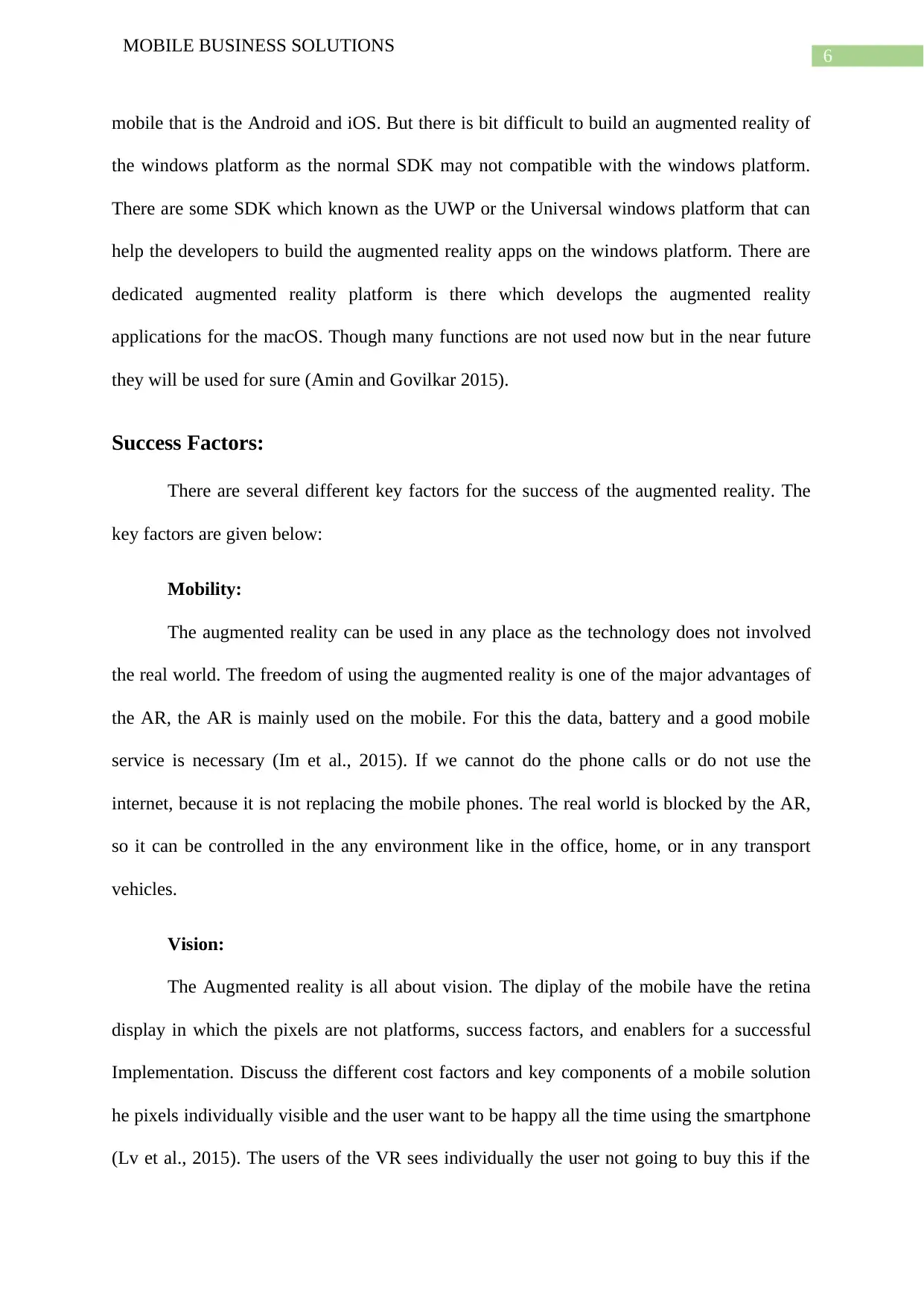
6
MOBILE BUSINESS SOLUTIONS
mobile that is the Android and iOS. But there is bit difficult to build an augmented reality of
the windows platform as the normal SDK may not compatible with the windows platform.
There are some SDK which known as the UWP or the Universal windows platform that can
help the developers to build the augmented reality apps on the windows platform. There are
dedicated augmented reality platform is there which develops the augmented reality
applications for the macOS. Though many functions are not used now but in the near future
they will be used for sure (Amin and Govilkar 2015).
Success Factors:
There are several different key factors for the success of the augmented reality. The
key factors are given below:
Mobility:
The augmented reality can be used in any place as the technology does not involved
the real world. The freedom of using the augmented reality is one of the major advantages of
the AR, the AR is mainly used on the mobile. For this the data, battery and a good mobile
service is necessary (Im et al., 2015). If we cannot do the phone calls or do not use the
internet, because it is not replacing the mobile phones. The real world is blocked by the AR,
so it can be controlled in the any environment like in the office, home, or in any transport
vehicles.
Vision:
The Augmented reality is all about vision. The diplay of the mobile have the retina
display in which the pixels are not platforms, success factors, and enablers for a successful
Implementation. Discuss the different cost factors and key components of a mobile solution
he pixels individually visible and the user want to be happy all the time using the smartphone
(Lv et al., 2015). The users of the VR sees individually the user not going to buy this if the
MOBILE BUSINESS SOLUTIONS
mobile that is the Android and iOS. But there is bit difficult to build an augmented reality of
the windows platform as the normal SDK may not compatible with the windows platform.
There are some SDK which known as the UWP or the Universal windows platform that can
help the developers to build the augmented reality apps on the windows platform. There are
dedicated augmented reality platform is there which develops the augmented reality
applications for the macOS. Though many functions are not used now but in the near future
they will be used for sure (Amin and Govilkar 2015).
Success Factors:
There are several different key factors for the success of the augmented reality. The
key factors are given below:
Mobility:
The augmented reality can be used in any place as the technology does not involved
the real world. The freedom of using the augmented reality is one of the major advantages of
the AR, the AR is mainly used on the mobile. For this the data, battery and a good mobile
service is necessary (Im et al., 2015). If we cannot do the phone calls or do not use the
internet, because it is not replacing the mobile phones. The real world is blocked by the AR,
so it can be controlled in the any environment like in the office, home, or in any transport
vehicles.
Vision:
The Augmented reality is all about vision. The diplay of the mobile have the retina
display in which the pixels are not platforms, success factors, and enablers for a successful
Implementation. Discuss the different cost factors and key components of a mobile solution
he pixels individually visible and the user want to be happy all the time using the smartphone
(Lv et al., 2015). The users of the VR sees individually the user not going to buy this if the
Paraphrase This Document
Need a fresh take? Get an instant paraphrase of this document with our AI Paraphraser
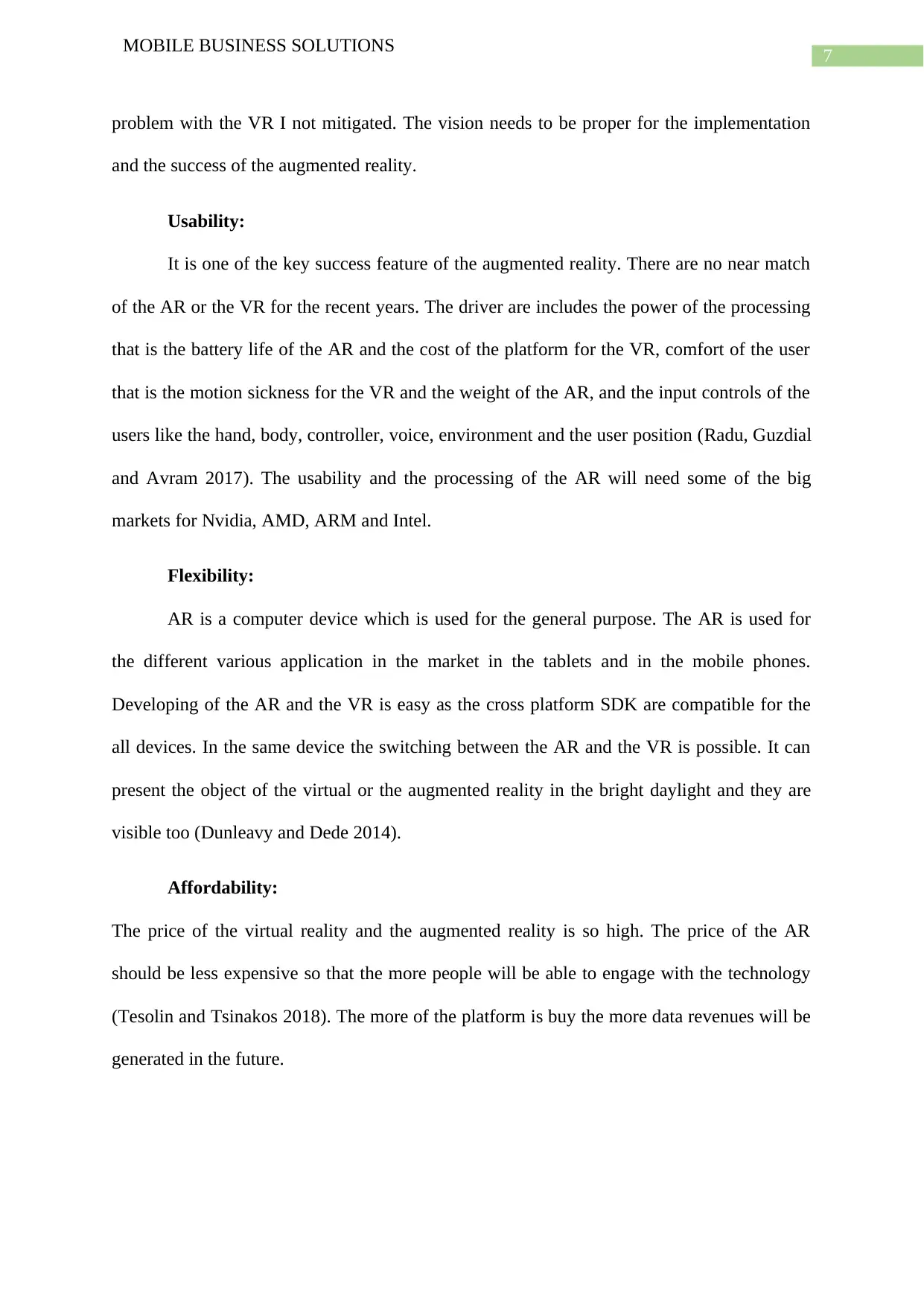
7
MOBILE BUSINESS SOLUTIONS
problem with the VR I not mitigated. The vision needs to be proper for the implementation
and the success of the augmented reality.
Usability:
It is one of the key success feature of the augmented reality. There are no near match
of the AR or the VR for the recent years. The driver are includes the power of the processing
that is the battery life of the AR and the cost of the platform for the VR, comfort of the user
that is the motion sickness for the VR and the weight of the AR, and the input controls of the
users like the hand, body, controller, voice, environment and the user position (Radu, Guzdial
and Avram 2017). The usability and the processing of the AR will need some of the big
markets for Nvidia, AMD, ARM and Intel.
Flexibility:
AR is a computer device which is used for the general purpose. The AR is used for
the different various application in the market in the tablets and in the mobile phones.
Developing of the AR and the VR is easy as the cross platform SDK are compatible for the
all devices. In the same device the switching between the AR and the VR is possible. It can
present the object of the virtual or the augmented reality in the bright daylight and they are
visible too (Dunleavy and Dede 2014).
Affordability:
The price of the virtual reality and the augmented reality is so high. The price of the AR
should be less expensive so that the more people will be able to engage with the technology
(Tesolin and Tsinakos 2018). The more of the platform is buy the more data revenues will be
generated in the future.
MOBILE BUSINESS SOLUTIONS
problem with the VR I not mitigated. The vision needs to be proper for the implementation
and the success of the augmented reality.
Usability:
It is one of the key success feature of the augmented reality. There are no near match
of the AR or the VR for the recent years. The driver are includes the power of the processing
that is the battery life of the AR and the cost of the platform for the VR, comfort of the user
that is the motion sickness for the VR and the weight of the AR, and the input controls of the
users like the hand, body, controller, voice, environment and the user position (Radu, Guzdial
and Avram 2017). The usability and the processing of the AR will need some of the big
markets for Nvidia, AMD, ARM and Intel.
Flexibility:
AR is a computer device which is used for the general purpose. The AR is used for
the different various application in the market in the tablets and in the mobile phones.
Developing of the AR and the VR is easy as the cross platform SDK are compatible for the
all devices. In the same device the switching between the AR and the VR is possible. It can
present the object of the virtual or the augmented reality in the bright daylight and they are
visible too (Dunleavy and Dede 2014).
Affordability:
The price of the virtual reality and the augmented reality is so high. The price of the AR
should be less expensive so that the more people will be able to engage with the technology
(Tesolin and Tsinakos 2018). The more of the platform is buy the more data revenues will be
generated in the future.
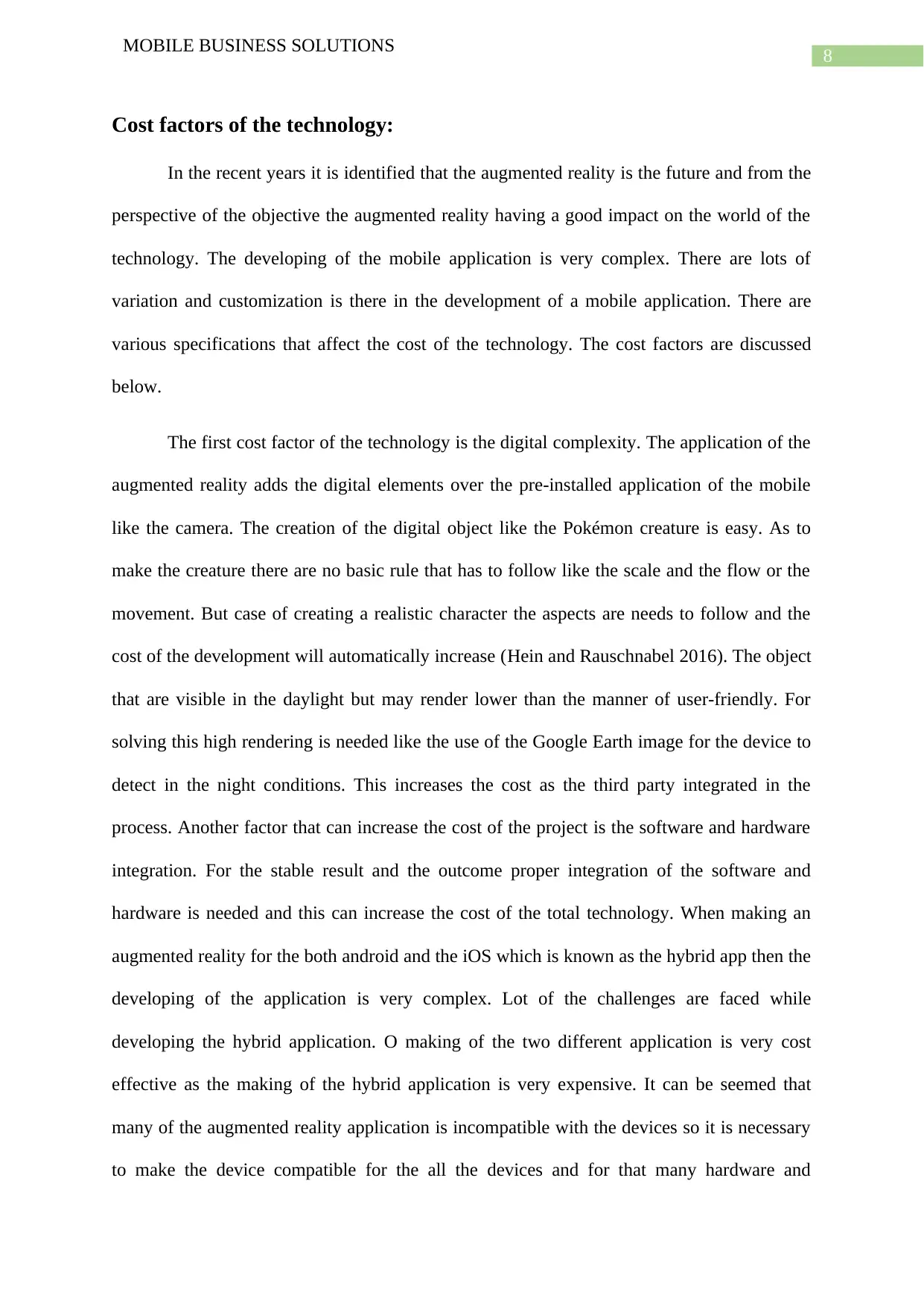
8
MOBILE BUSINESS SOLUTIONS
Cost factors of the technology:
In the recent years it is identified that the augmented reality is the future and from the
perspective of the objective the augmented reality having a good impact on the world of the
technology. The developing of the mobile application is very complex. There are lots of
variation and customization is there in the development of a mobile application. There are
various specifications that affect the cost of the technology. The cost factors are discussed
below.
The first cost factor of the technology is the digital complexity. The application of the
augmented reality adds the digital elements over the pre-installed application of the mobile
like the camera. The creation of the digital object like the Pokémon creature is easy. As to
make the creature there are no basic rule that has to follow like the scale and the flow or the
movement. But case of creating a realistic character the aspects are needs to follow and the
cost of the development will automatically increase (Hein and Rauschnabel 2016). The object
that are visible in the daylight but may render lower than the manner of user-friendly. For
solving this high rendering is needed like the use of the Google Earth image for the device to
detect in the night conditions. This increases the cost as the third party integrated in the
process. Another factor that can increase the cost of the project is the software and hardware
integration. For the stable result and the outcome proper integration of the software and
hardware is needed and this can increase the cost of the total technology. When making an
augmented reality for the both android and the iOS which is known as the hybrid app then the
developing of the application is very complex. Lot of the challenges are faced while
developing the hybrid application. O making of the two different application is very cost
effective as the making of the hybrid application is very expensive. It can be seemed that
many of the augmented reality application is incompatible with the devices so it is necessary
to make the device compatible for the all the devices and for that many hardware and
MOBILE BUSINESS SOLUTIONS
Cost factors of the technology:
In the recent years it is identified that the augmented reality is the future and from the
perspective of the objective the augmented reality having a good impact on the world of the
technology. The developing of the mobile application is very complex. There are lots of
variation and customization is there in the development of a mobile application. There are
various specifications that affect the cost of the technology. The cost factors are discussed
below.
The first cost factor of the technology is the digital complexity. The application of the
augmented reality adds the digital elements over the pre-installed application of the mobile
like the camera. The creation of the digital object like the Pokémon creature is easy. As to
make the creature there are no basic rule that has to follow like the scale and the flow or the
movement. But case of creating a realistic character the aspects are needs to follow and the
cost of the development will automatically increase (Hein and Rauschnabel 2016). The object
that are visible in the daylight but may render lower than the manner of user-friendly. For
solving this high rendering is needed like the use of the Google Earth image for the device to
detect in the night conditions. This increases the cost as the third party integrated in the
process. Another factor that can increase the cost of the project is the software and hardware
integration. For the stable result and the outcome proper integration of the software and
hardware is needed and this can increase the cost of the total technology. When making an
augmented reality for the both android and the iOS which is known as the hybrid app then the
developing of the application is very complex. Lot of the challenges are faced while
developing the hybrid application. O making of the two different application is very cost
effective as the making of the hybrid application is very expensive. It can be seemed that
many of the augmented reality application is incompatible with the devices so it is necessary
to make the device compatible for the all the devices and for that many hardware and
⊘ This is a preview!⊘
Do you want full access?
Subscribe today to unlock all pages.

Trusted by 1+ million students worldwide
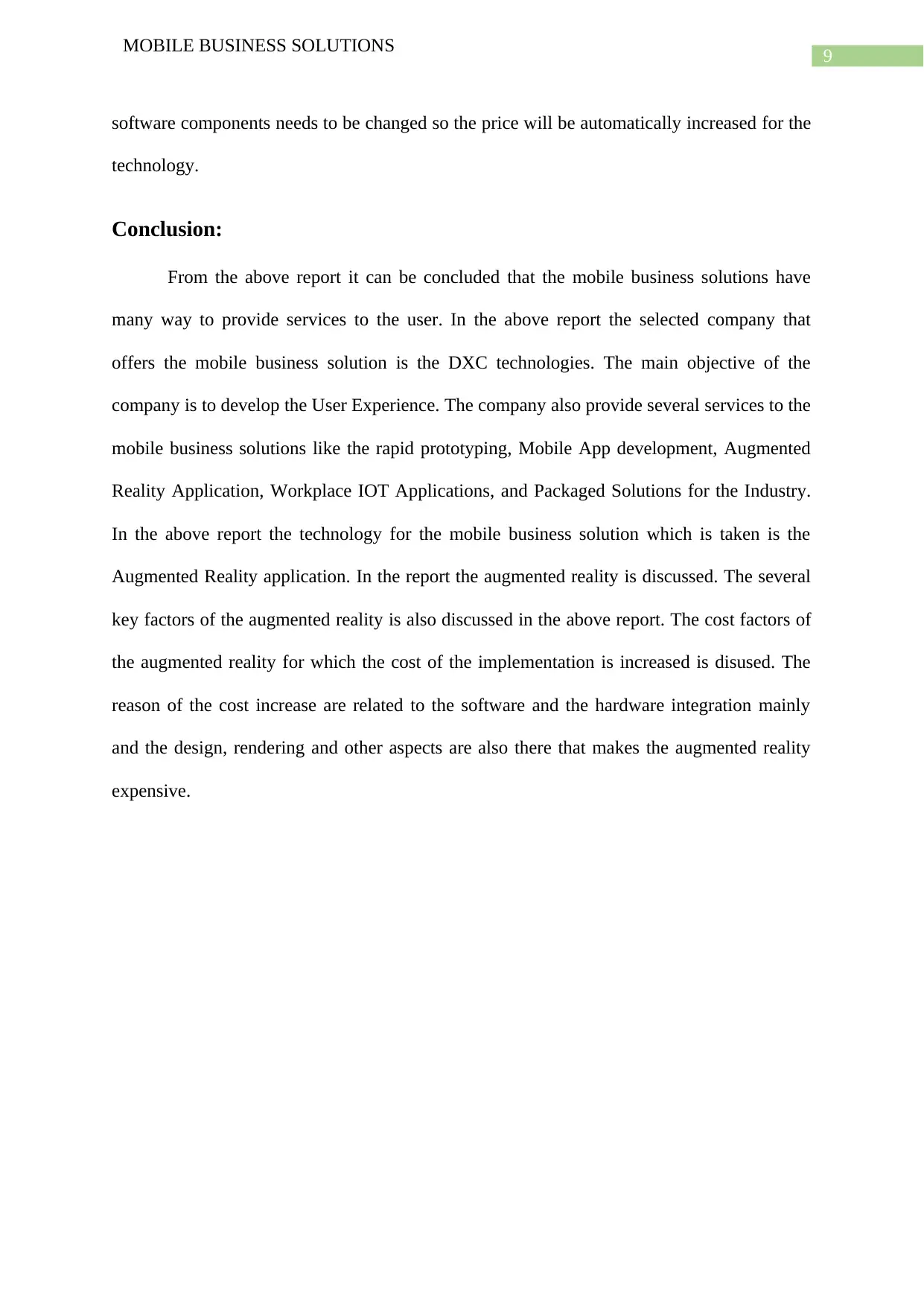
9
MOBILE BUSINESS SOLUTIONS
software components needs to be changed so the price will be automatically increased for the
technology.
Conclusion:
From the above report it can be concluded that the mobile business solutions have
many way to provide services to the user. In the above report the selected company that
offers the mobile business solution is the DXC technologies. The main objective of the
company is to develop the User Experience. The company also provide several services to the
mobile business solutions like the rapid prototyping, Mobile App development, Augmented
Reality Application, Workplace IOT Applications, and Packaged Solutions for the Industry.
In the above report the technology for the mobile business solution which is taken is the
Augmented Reality application. In the report the augmented reality is discussed. The several
key factors of the augmented reality is also discussed in the above report. The cost factors of
the augmented reality for which the cost of the implementation is increased is disused. The
reason of the cost increase are related to the software and the hardware integration mainly
and the design, rendering and other aspects are also there that makes the augmented reality
expensive.
MOBILE BUSINESS SOLUTIONS
software components needs to be changed so the price will be automatically increased for the
technology.
Conclusion:
From the above report it can be concluded that the mobile business solutions have
many way to provide services to the user. In the above report the selected company that
offers the mobile business solution is the DXC technologies. The main objective of the
company is to develop the User Experience. The company also provide several services to the
mobile business solutions like the rapid prototyping, Mobile App development, Augmented
Reality Application, Workplace IOT Applications, and Packaged Solutions for the Industry.
In the above report the technology for the mobile business solution which is taken is the
Augmented Reality application. In the report the augmented reality is discussed. The several
key factors of the augmented reality is also discussed in the above report. The cost factors of
the augmented reality for which the cost of the implementation is increased is disused. The
reason of the cost increase are related to the software and the hardware integration mainly
and the design, rendering and other aspects are also there that makes the augmented reality
expensive.
Paraphrase This Document
Need a fresh take? Get an instant paraphrase of this document with our AI Paraphraser
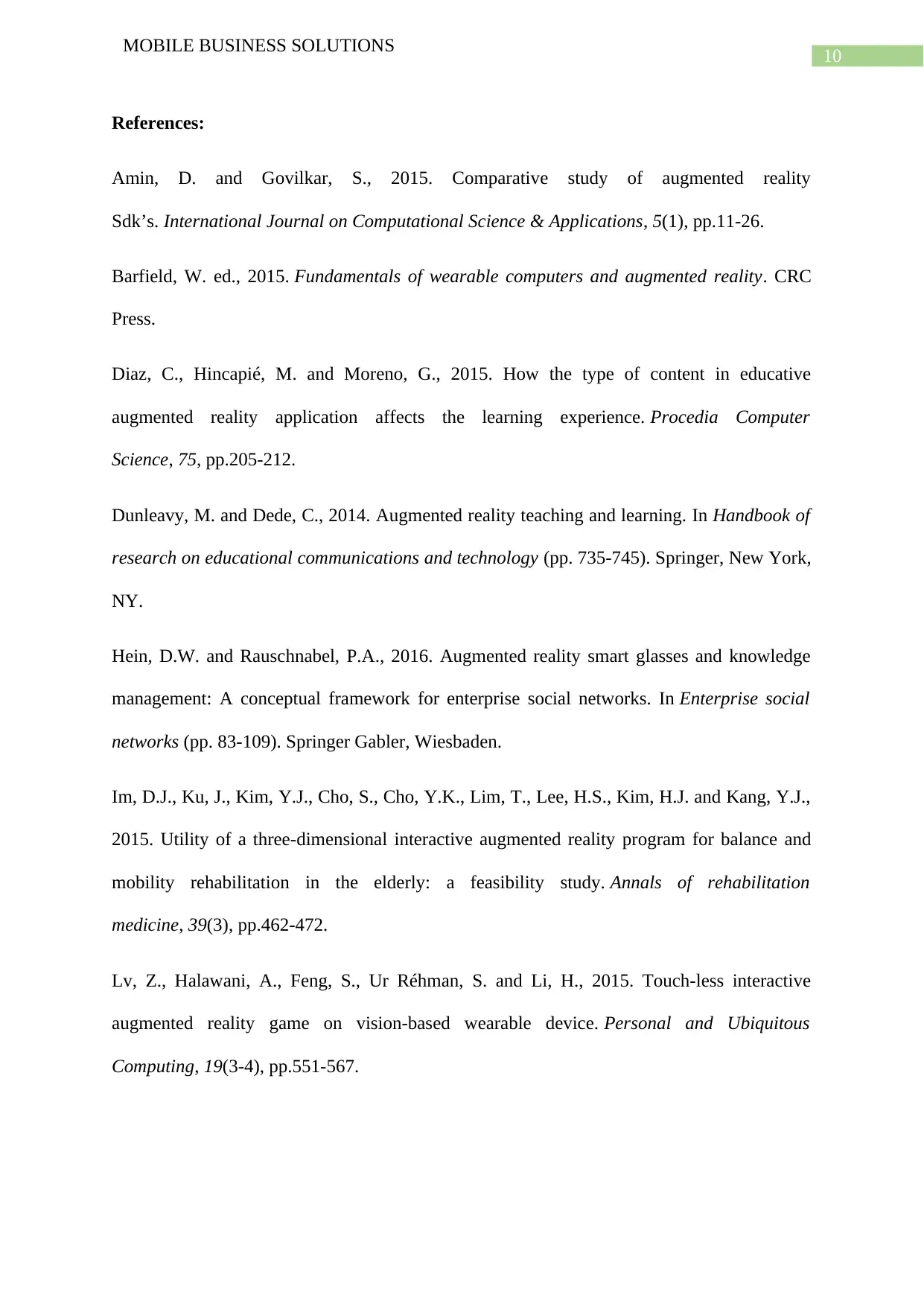
10
MOBILE BUSINESS SOLUTIONS
References:
Amin, D. and Govilkar, S., 2015. Comparative study of augmented reality
Sdk’s. International Journal on Computational Science & Applications, 5(1), pp.11-26.
Barfield, W. ed., 2015. Fundamentals of wearable computers and augmented reality. CRC
Press.
Diaz, C., Hincapié, M. and Moreno, G., 2015. How the type of content in educative
augmented reality application affects the learning experience. Procedia Computer
Science, 75, pp.205-212.
Dunleavy, M. and Dede, C., 2014. Augmented reality teaching and learning. In Handbook of
research on educational communications and technology (pp. 735-745). Springer, New York,
NY.
Hein, D.W. and Rauschnabel, P.A., 2016. Augmented reality smart glasses and knowledge
management: A conceptual framework for enterprise social networks. In Enterprise social
networks (pp. 83-109). Springer Gabler, Wiesbaden.
Im, D.J., Ku, J., Kim, Y.J., Cho, S., Cho, Y.K., Lim, T., Lee, H.S., Kim, H.J. and Kang, Y.J.,
2015. Utility of a three-dimensional interactive augmented reality program for balance and
mobility rehabilitation in the elderly: a feasibility study. Annals of rehabilitation
medicine, 39(3), pp.462-472.
Lv, Z., Halawani, A., Feng, S., Ur Réhman, S. and Li, H., 2015. Touch-less interactive
augmented reality game on vision-based wearable device. Personal and Ubiquitous
Computing, 19(3-4), pp.551-567.
MOBILE BUSINESS SOLUTIONS
References:
Amin, D. and Govilkar, S., 2015. Comparative study of augmented reality
Sdk’s. International Journal on Computational Science & Applications, 5(1), pp.11-26.
Barfield, W. ed., 2015. Fundamentals of wearable computers and augmented reality. CRC
Press.
Diaz, C., Hincapié, M. and Moreno, G., 2015. How the type of content in educative
augmented reality application affects the learning experience. Procedia Computer
Science, 75, pp.205-212.
Dunleavy, M. and Dede, C., 2014. Augmented reality teaching and learning. In Handbook of
research on educational communications and technology (pp. 735-745). Springer, New York,
NY.
Hein, D.W. and Rauschnabel, P.A., 2016. Augmented reality smart glasses and knowledge
management: A conceptual framework for enterprise social networks. In Enterprise social
networks (pp. 83-109). Springer Gabler, Wiesbaden.
Im, D.J., Ku, J., Kim, Y.J., Cho, S., Cho, Y.K., Lim, T., Lee, H.S., Kim, H.J. and Kang, Y.J.,
2015. Utility of a three-dimensional interactive augmented reality program for balance and
mobility rehabilitation in the elderly: a feasibility study. Annals of rehabilitation
medicine, 39(3), pp.462-472.
Lv, Z., Halawani, A., Feng, S., Ur Réhman, S. and Li, H., 2015. Touch-less interactive
augmented reality game on vision-based wearable device. Personal and Ubiquitous
Computing, 19(3-4), pp.551-567.
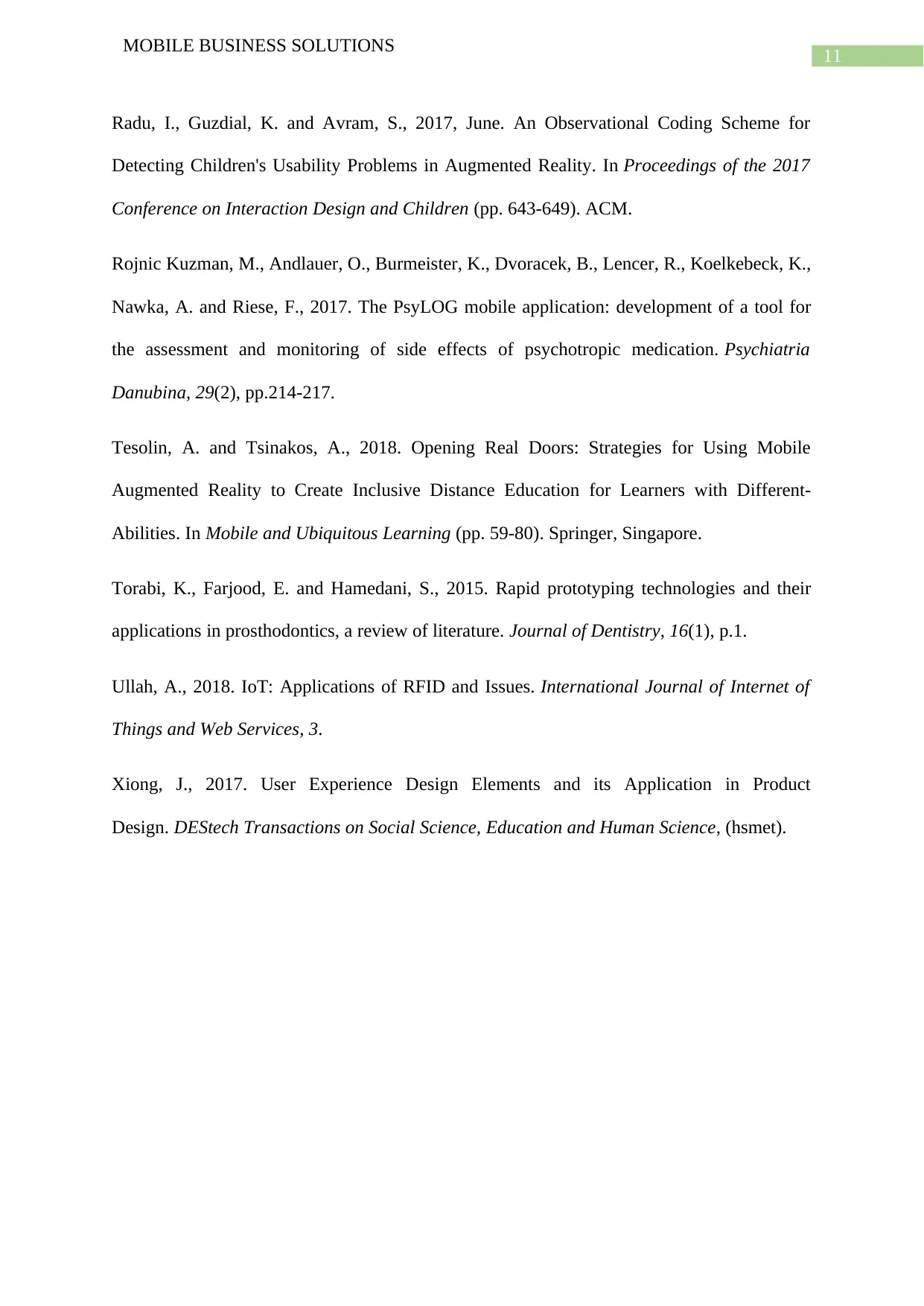
11
MOBILE BUSINESS SOLUTIONS
Radu, I., Guzdial, K. and Avram, S., 2017, June. An Observational Coding Scheme for
Detecting Children's Usability Problems in Augmented Reality. In Proceedings of the 2017
Conference on Interaction Design and Children (pp. 643-649). ACM.
Rojnic Kuzman, M., Andlauer, O., Burmeister, K., Dvoracek, B., Lencer, R., Koelkebeck, K.,
Nawka, A. and Riese, F., 2017. The PsyLOG mobile application: development of a tool for
the assessment and monitoring of side effects of psychotropic medication. Psychiatria
Danubina, 29(2), pp.214-217.
Tesolin, A. and Tsinakos, A., 2018. Opening Real Doors: Strategies for Using Mobile
Augmented Reality to Create Inclusive Distance Education for Learners with Different-
Abilities. In Mobile and Ubiquitous Learning (pp. 59-80). Springer, Singapore.
Torabi, K., Farjood, E. and Hamedani, S., 2015. Rapid prototyping technologies and their
applications in prosthodontics, a review of literature. Journal of Dentistry, 16(1), p.1.
Ullah, A., 2018. IoT: Applications of RFID and Issues. International Journal of Internet of
Things and Web Services, 3.
Xiong, J., 2017. User Experience Design Elements and its Application in Product
Design. DEStech Transactions on Social Science, Education and Human Science, (hsmet).
MOBILE BUSINESS SOLUTIONS
Radu, I., Guzdial, K. and Avram, S., 2017, June. An Observational Coding Scheme for
Detecting Children's Usability Problems in Augmented Reality. In Proceedings of the 2017
Conference on Interaction Design and Children (pp. 643-649). ACM.
Rojnic Kuzman, M., Andlauer, O., Burmeister, K., Dvoracek, B., Lencer, R., Koelkebeck, K.,
Nawka, A. and Riese, F., 2017. The PsyLOG mobile application: development of a tool for
the assessment and monitoring of side effects of psychotropic medication. Psychiatria
Danubina, 29(2), pp.214-217.
Tesolin, A. and Tsinakos, A., 2018. Opening Real Doors: Strategies for Using Mobile
Augmented Reality to Create Inclusive Distance Education for Learners with Different-
Abilities. In Mobile and Ubiquitous Learning (pp. 59-80). Springer, Singapore.
Torabi, K., Farjood, E. and Hamedani, S., 2015. Rapid prototyping technologies and their
applications in prosthodontics, a review of literature. Journal of Dentistry, 16(1), p.1.
Ullah, A., 2018. IoT: Applications of RFID and Issues. International Journal of Internet of
Things and Web Services, 3.
Xiong, J., 2017. User Experience Design Elements and its Application in Product
Design. DEStech Transactions on Social Science, Education and Human Science, (hsmet).
⊘ This is a preview!⊘
Do you want full access?
Subscribe today to unlock all pages.

Trusted by 1+ million students worldwide
1 out of 12
Related Documents
Your All-in-One AI-Powered Toolkit for Academic Success.
+13062052269
info@desklib.com
Available 24*7 on WhatsApp / Email
![[object Object]](/_next/static/media/star-bottom.7253800d.svg)
Unlock your academic potential
© 2024 | Zucol Services PVT LTD | All rights reserved.





